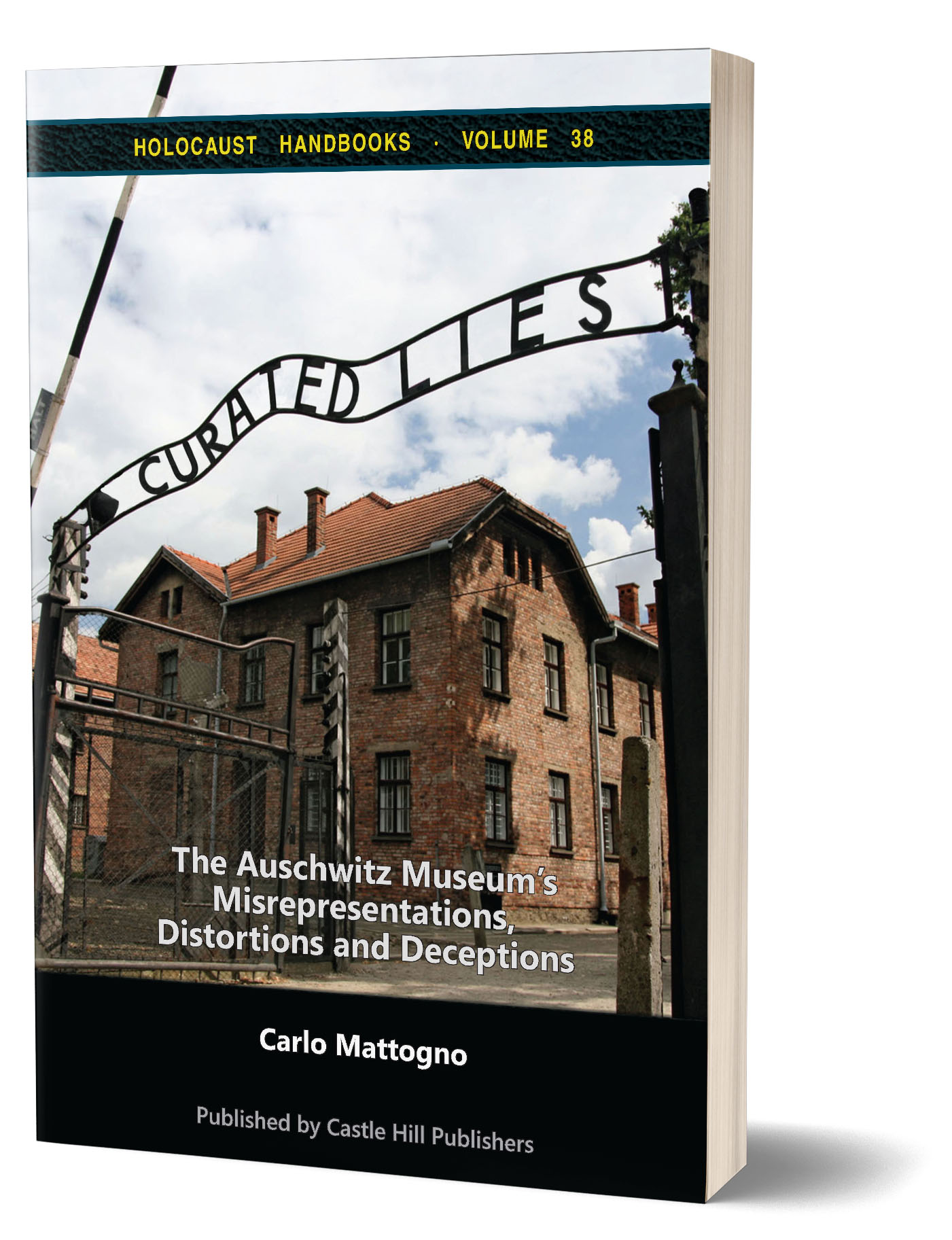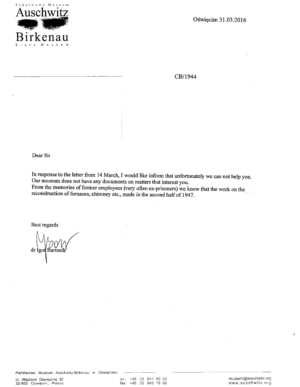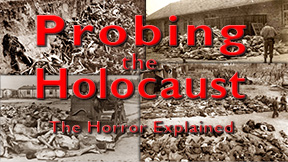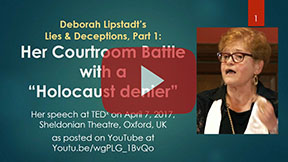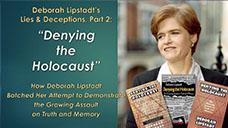In the summer of 1992, the U.S.-American atheist Jew – some think that’s a triple contradiction – David Cole went to Auschwitz and recorded on video tape what the attractive young Polish tour guide there had to tell him about the alleged gas chamber at the Auschwitz Main Camp, which is a room inside what used to be a crematorium. She claimed that everything David was seeing there was indeed authentic, genuine and in its original state (Cole 1993, starting at 9:47).
Later during his tour David managed to interview Franciszek Piper, at that time curator of the museum’s historical archive. He confirmed in front of David’s camera that what tourists are seeing to this day is neither authentic nor genuine or original. It was all “reconstructed” shortly after the war to look similar to what the Auschwitz Museum thought back then it would have looked when this place was allegedly used by the SS to mass murder Jews and other inmates with poison gas.
In particular the four holes in the ceiling of the purported gas chamber, through which the SS murderers ostensibly poured in the lethal Zyklon B pellets, were confirmed by Dr. Piper to have been put into place by the Auschwitz Museum after the war. Yet he insisted that they were put at exactly the same spots where the old, SS-made holes had been, as traces of these holes, which were supposedly filled up by the SS in 1943 or 1944, were allegedly still visible after war’s end (Cole 1993, 28:38-28:51).
Fact is, though, that until the turn of the 20th to the 21st century, Auschwitz Museum officials told their tour guides to tell tourists a story of authenticity which the officials knew was not true. So they had their tour guides lie to the millions of tourists visiting that most revered, holy shrine of Holocaustianity. They lied, plain and simple, though the guides may not have known it, or cared.
PowerPoint presentation of “Curated Lies”
That changed later, though. After having been deeply embarrassed by David Cole’s revealing exposé, the museum officials finally mustered the decency to own up to this manipulation and put up some signs openly admitting these post-war changes. On another sign, the Museum juxtaposes the building’s layout as shown in blueprints of the year 1942 (when the structure’s morgue was allegedly used as a homicidal gas chamber) with today’s layout, although without explaining much of anything. (See the illustrations in Eric Hunt’s paper in the present book.) It’s up to the visitor to make sense of it all.
For the critical investigator, the first pivotal question is: what evidence exists for the Auschwitz Museum’s claim that right after the war there were traces of former openings visible on the ceiling of that building’s former morgue? Because if there weren’t any such traces, then the claims to the contrary would be yet another Auschwitz lie by the museum. If there weren’t any traces of holes, then the claimed holes never existed in that ceiling. And if those holes never existed, then no SS man ever poured Zyklon B through that roof, as many witnesses have claimed. And in inexorable consequence, this morgue could then not have served as a homicidal gas chamber as claimed by the museum.
This question is therefore at the very center of the entire issue.
Do we have to simply take Dr. Piper’s word for it, who was merely a small child at war’s end (he was born in 1941), and thus cannot possibly know from his own experience what he is telling us about the state of the building at war’s end? Or do we have to take at face value the statements of any other person who has claimed to have seen these holes during the war?
As Carlo Mattogno has shown elsewhere (2005a, 89-97; 2011, pp. 342-359), these witness statements are highly contradictory not only regarding the number and shape of these holes. They are actually unreliable for many different reasons: internal inconsistencies, conflict with material and documentary evidence, physical and technical impossibilities, obvious absurdities, and clearly propagandistic overtones, to name only a few. Hence relying on those statements does not comport with an investigator’s claiming to be critical.
Insofar as reliable documentary or physical evidence is concerned, it is therefore unknown in what exact condition this building was in early 1945 when it was occupied by the Soviets. The late French orthodox historian Jean-Claude Pressac, who has thoroughly investigated the Auschwitz Museum’s archives with the full support of the museum authorities, wrote about that (1989, p. 133):
“It would appear that the photos of the interior showing the state of the premises were not taken at the beginning of 1945, which is a pity because the restructuring of the building back into a Krematorium began immediately after the liberation. […] Because of the lack of original documents and the transformations that have been made (see the drawing of the present state of the premises at the end of this chapter), it was not possible before to materially demonstrate the existence of a homicidal gas chamber in the former morgue of Krematorium I.”
But we didn’t want to take Pressac’s word at face value either, so a friend of mine, unsuspected of harboring any iconoclastic views, managed to get a well-established academic involved in research of a similar nature to approach the current director of the Auschwitz-Museum, Dr. Piotr Setkiewicz, with two simple questions asked in a letter dated March 14, 2016:
“1) Did Soviet or Polish authorities document, or photograph, the interior of the crematorium, before any alterations were done? I would like to know about the layout of the interior, ceiling openings, and so on. Are there any photographs, drawings, or descriptions? If so, can I obtain copies?
2) It is clear that Soviet/Polish authorities made significant post-war modifications to the building. Is there any documentation about this? Any description or documents showing the work performed—that is, anything about cost estimates, blueprints, work orders, materials, etc? And again, if so, can I obtain copies?”
Here is what Dr. Igor Bartosik from the Museum’s Research Center answered in a letter dated March 31, 2016 (see reproduction on p. 15):
“Dear Sir
In response to the letter from 14 March, I would like [to] inform [you] that unfortunately we can not help you. Our museum does not have any documents on matters that interest you.
From the memories of former employees (very often ex-prisoners) we know that the work on the reconstruction of furnaces, chimney etc., [were] made in the second half of 1947.
Best regards
dr Igor Bartosik”
So, now we have it from the horse’s mouth: There is no evidence at all as to the exact condition this building was in at war’s end, and the changes made to turn that building into the museum’s most prized exhibit were not documented either.
Asked which “memories of former employees” contain information about the reconstruction, Dr. Bartosik referred to the testimony of Adam Źłobnicki dated 18 November 1981. Źłobnicki had been interned at Auschwitz during the war with the inmate number 165010, and had worked as a guard at the Auschwitz memorial since 13 June 1946.
If we follow Źłobnicki’s statement, he remembered that right after the war Krematorium I had no chimney, and that the interior of the gas chamber looked different from what it looked like later. On the holes in the ceiling of this room, Źłobnicki stated the following:[1]
“I remember exactly that the introduction holes for the Zyklon B gas, which used to be in the roof of the crematorium, were also reconstructed. The task of those charged with this reconstruction was facilitated by the fact that distinct traces of the cement patches of the earlier openings were left in the spots of the old introduction holes. Hence new openings were broken through at the same spots, and little chimneys [i.e. introduction shafts] were built with bricks [domurowano]. This work was also done in the years 1946-1947.”
The question here is, of course, how a guard not involved in the reconstruction could know any details of what was going on inside the building during the reconstruction? In particular since what he says about the newly-built introduction shafts is wrong: they were and still are made merely of wooden boards, not of bricks.
So all we have is an inaccurate account from a bystander, who may or may not have adjusted his account to what those recording it – the Communist museum officials of the early 1980s – wanted to hear from him.
Any assertion by any employee of the Auschwitz Museum that the current holes were opened at exactly the same locations as they had been during the war is therefore based not on solid, reliable evidence at all. They may or – considering what is at stake for them – must be convinced that what Źłobnicki stated is true, but that doesn’t make it true.
But what is true?
We know that the Polish legal authorities initiated large-scale criminal investigations against the former camp commandant Rudolf Höss and against the entire staff of the Auschwitz camp garrison right after the camp’s Soviet occupation. For this they collected all kinds of evidence in support of mass-murder claims. Photos of the claimed mass-murder sites as found right after the Soviet occupation would have been of the utmost importance, in particular if they could support any mass-murder claims.
The fact that no such photos of the ceiling of the alleged former gas chamber in Crematorium I exist raises the suspicion that such photos would not have shown what the Soviet and Polish authorities wanted the world to believe. This suspicion is supported by the fact that no document exists regarding the changes made to this entire building after the camp’s Soviet occupation. This indicates that the motivation behind those changes was not to meticulously restore something as accurately as possible, but to cover up manipulations.
Today we can infer these postwar changes only by comparing the current state with German construction blueprints of the wartime.
The undocumented manipulation of evidence central to a criminal investigation is itself a crime, by the way. Wikipedia writes in its entry on “Spoliation of evidence”:
“The spoliation of evidence is the intentional, reckless, or negligent withholding, hiding, altering, fabricating, or destroying of evidence relevant to a legal proceeding. Spoliation has two possible consequences: in jurisdictions where it is the (intentional) act is criminal by statute, it may result in fines and incarceration […].
The spoliation inference is a negative evidentiary inference that a finder of fact can draw from a party’s destruction of a document or thing that is relevant to an ongoing or reasonably foreseeable civil or criminal proceeding: the finder of fact can review all evidence uncovered in as strong a light as possible against the spoliator and in favor of the opposing party.”
In most countries, Poland included, tampering with evidence is illegal and can thus be prosecuted. Hence we are not dealing merely with a case of sloppiness here, but with a potential crime of the Soviet and/or Polish officials involved in “reconstructing” Crematorium I right after the war, whoever they were.
There is a way out of this mess, though. It was first pointed out by me in the first, 1993 German edition of my expert report (in Chapter 1.2.), an expanded English edition of which was first published in 2003 (Rudolf 2003, p. 87):
“If the SS had put these holes in the concrete during the war, one must assume that they would have taken care to evenly distribute these holes in the ceiling of the original(!) morgue in order to ensure an even distribution of the Zyklon B inside the room. The stacks today, however, are only evenly distributed in the ceiling of this room if one considers the washing room, which was only incorporated after the war(!), as an integral part of the morgue (‘gas chamber’.) […]. Thus, the arrangement of today’s introduction holes only makes sense if they were created especially for its present status as a falsely dimensioned ‘reconstruction for Museum purposes’ (B. Bailer-Galanda) after the war. This by itself is strong circumstantial evidence that those holes were chiseled in after the interior walls of the former air-raid shelter—one too many of them—had been torn down by the Soviets or the Poles.”
Carlo Mattogno expanded on that theme in three studies by investigating this issue more deeply (2004c, 2005a, 2011). Eric Hunt will summarize the highlights of these findings in the first part of the present study.
There is a second pivotal question concerning the doors leading to the room within Crematorium I at Auschwitz which is said to have been used as a homicidal gas chamber: What kind of doors did the room have?
For several decades after the war, tourists visiting the museum entered the building using an opening that has a heavy steel door sporting an ominous peephole. It looks like the kind of gas-tight door one would expect for a homicidal gas chamber. The problem is that this door was added to this building only in late 1944 when it was converted to an air-raid shelter. Hence the door we see there today is an absolutely innocuous air-raid-shelter door. Yet for decades tourists were told by tour guides that this was the way the victims entered the death chamber. The museum tour guides, again improperly instructed by the museum’s officials, told a lie, whether they were aware of it or not.
This has changed in recent years. The entrance way fitted with the air-raid-shelter door is no longer used by tourists to enter the building, and from layout drawings shown on a sign displayed in front of that crematorium, tourists can infer that this entry was not there when the place was said to have been used to mass murder people – although it is not expressly stated in the drawings’ caption. But how many tourists actually look thoroughly at those drawings and make inferences about construction details?
It is true that the current room on display as a “gas chamber” has two flimsy wooden doors which anyone locked inside it could have bashed down easily. One of these doors even has a thin, easily breakable window pane. It is also true that there is no door at all between that “gas chamber” and the furnace room. Since it is admitted today that this is not what the place looked like originally, such an argument would be rather pointless to make, though. Hence I abstain from illustrating here what I mean. It just emphasizes the fact that what we are shown there today does not merit the term “reconstruction.”
The really interesting question is, what kind of doors were in that room at the time when it supposedly served as a chemical slaughter house? The only door about which we have any revealing information gleaned from original wartime blueprints is the one connecting the morgue a.k.a. “gas chamber” to the furnace room. It seems to have been a swinging door, which, if true, would have some severe implication for the morgue’s claimed use as a gas chamber.
Now, since an image says more than a thousand words, we won’t repeat here what has been written before with so many words. Rather, we let images speak. Eric Hunt, a specialist in creating documentaries on historical topics, has condensed the essence of these three issues – holes, victims’ entrance, and doors – and explains them with numerous images. They show without the shadow of a doubt that the museum’s claim is certainly wrong – if not to say it’s a lie – that today’s Zyklon-B-introduction chimneys were installed at the same spots where the SS had set up similar devices during the war. And the blueprints show that the door connecting the morgue to the furnace room could in no way have served to lock in a panicky crowd nor to seal off massive amounts of poison gas.[2]
In other words: the Auschwitz Museum hasn’t stopped lying. It has merely reduced the extent of its mendacious activities by indirectly admitting some of its lies of the past, yet clinging to others which it just can’t give up without jeopardizing the whole orthodox narrative.
The first section of this book addresses issues affecting millions – the millions of tourists lied to at Auschwitz every year – and could thus potentially benefit both them and additional millions of readers. This is why we have decided to include it in this book.
The second part, on the other hand, may be of interest only to a select few scholars specializing in the details of archival research on Auschwitz. However, since the orthodox narrative told to millions of tourists rests on the foundations of that archival material, it indirectly affects the whole story more profoundly than anything else. If the scholars are shown to lie, then the emperor is shown to wear no clothes.
For that reason, the second, much longer part of the present study is a thorough analysis of the Auschwitz Museum’s latest attempt at pulling the wool over the eyes of specialized historians and aficionados interested in the Auschwitz narrative. Ever since the end of the war, the museum has been desperate to find documentary evidence for the claim that people were mass murdered at Auschwitz in huge chemical slaughterhouses called “gas chambers.” They have been utterly unsuccessful with this. Yet they keep on claiming the contrary, while at the same time ignoring all publications refuting their claims. These museum publications, the most recent of which Carlo will cite copiously in his analysis, have been repeatedly revealed as being littered with mistranslations, distortions, inconsistencies, logical fallacies, contradictions and absurdities. Carlo’s devastating analysis laid out in the present book proves these accusations to the point where one is tempted to say: Enough! Are these Auschwitz scholars insane?
Probably not. But the mindboggling deficiencies of the latest publication by the Auschwitz Museum left me wondering: How can this be explained? Are we to assume that the scholars at the Auschwitz Museum are utterly incompetent? Although this is remotely possible, I don’t think it is very likely. Well, if not that, then what other explanation is there than to conclude that they must be profoundly mendacious? And if that is the case, then the question is:
Why Do They Lie?
Well, first of all, telling the truth about Auschwitz is a criminal offense in Poland, as it is in many other countries, like Israel, Germany, Austria, Russia, France, etc. Yet, considering that the scholars at the Auschwitz Museum are the High Priests of the Auschwitz Gospel, if they mustered the courage to stand up and say: “Enough is enough, we can’t take it anymore!”, who could stop them? After all, telling the truth about Auschwitz is a crime primarily and foremost because of the utterly immoral lies perpetrated by the scholars at the Auschwitz Museum for more than seven decades and counting. Take those scholars out of the equation, and the whole thing should collapse.
Of course, these Auschwitz scholars would not merely risk criminal prosecutions, even if they were acquitted at the end of a certainly excruciating, drawn-out procedure. They’d also lose their jobs. They’d end their careers right there. Neither the mass media nor the politicians in Poland or any other nation deeply invested in the myth – first and foremost Germany, the U.S. and Israel – would forgive such iconoclastic heresy.
And then there is what the Germans call Raubsicherungspolitik – securing the spoils of a robbery. After World War II, Poland annexed large swaths of German territories and expelled its roughly eight million ethnic-German inhabitants in what constitutes the largest ethnic cleansing in the history of mankind. There is nothing in international law that can ever turn this crime against humanity into a legal, acceptable act. Except, of course, the Holocaust, a sin for which Germany and the Germans must endure any kind of punishment, no matter what. What Poland did right after the war and has been doing since, is a simple act of securing her spoils by focusing on German war crimes, by exaggerating them, even by inventing them. Similarly to Israel, Poland’s post-war identity is to a large degree based upon her self-perceived image as Germany’s victim. And many Poles feel it is important to keep any potential German demand for territorial restitution at bay by constantly waving the Holocaust in everyone’s face.
But Poland’s existence does not depend on the orthodox Holocaust narrative. Poland existed before the Second World War, and it will keep existing even after the orthodox Holocaust narrative has been cut down to its actual size supported by verifiable evidence. In addition, Poland has nothing to fear from Germany today. Germany’s population is experiencing a demographic collapse. Germans aren’t even able to populate what was left to them after the war, let alone any other territories. Ironically, the same is true for Poland, whose demographic trends run pretty much parallel to Germany’s. Both countries are tied to each other by geography, ethnicity, history, culture, and by their current fate of societal disaster triggered by their populations going extinct, plain and simple.
So why bickering about the Holocaust? Why lie about it?
All the more so since the orthodox Holocaust narrative is the most important weapon used against any European identity movement trying to prevent or rather revert the collapse of Europe’s 4,000 year old civilization.[3] By simply calling any European identity movement “Nazis” (say: potential gas-chamber mass murderers), any such movement is doomed to fail, and has been failing for decades.
I therefore dare say that those promoting the orthodox Holocaust narrative are the main perpetrators in wiping out European civilization. And among them, the scholars at the Auschwitz Museum, the holiest of all temples of Holocaustianity, bear the heaviest responsibility.
If Europe’s civilization is going to be a matter of the past within this or the next century or so, you can all point at the scholars at the Auschwitz Museum. They did it! Provided anyone is still interested in who did it.
Germar Rudolf
Red Lion, 29 April 2016
Notes
[1] APMO-B, Statements, vol. 96, p. 60.
[2] It is possible that what we see in those blueprints actually consists not of one swinging door but of two doors, one opening into the morgue, the other into the furnace room. Although possible and well-suited for thermal insulation, such a layout would be cumbersome to deal with for carrying corpses to and fro. What matters, however, is that a door opening into the morgue could not have been opened if hundreds of corpses had piled up in the morgue after a claimed gassing, because when suffocating, people are trying to get out the door, hence they pile up and die in front of them. So either way, that door design was no good for a homicidal gas chamber.
[3] Look at the 3,600-year-old “Nebra sky disk” to realize the age and early sophistication of European civilization; https://en.wikipedia.org/wiki/Nebra_sky_disk
Sources
– Cole, David, “David Cole in Auschwitz: David Cole Interviews Dr. Franciszek Piper, Director, Auschwitz State Museum”, VHS video, 1993; www.youtube.com/watch?v=iXKHw0EZrqM; www.codoh.com/library/document/1001.
– Carlo Mattogno, “The Openings for the Introduction of Zyklon B, Part 1: The Roof of the Morgue of Crematorium I at Auschwitz,” The Revisionist 2(4) (2004c), pp. 411-419, www.codoh.com/library/document/1751/
– Carlo Mattogno, Auschwitz: Crematorium I and the Alleged Homicidal Gassings. Theses & Dissertations Press, Chicago, 2005a; 2nd, revised ed., Castle Hill Publishers, Uckfield 2016 (in preparation).
– Carlo Mattogno, “The Elusive Holes of Death,” in: Germar Rudolf, Carlo Mattogno, Auschwitz Lies, 2nd ed., The Barnes Review, Washington, D.C. 2011, pp. 279-394.
– Pressac, Jean-Claude, Auschwitz: Technique and operation of the gas chambers. The Beate Klarsfeld Foundation, New York, 1989.
– Rudolf, Germar, The Rudolf Report: Expert Report on Chemical and Technical Aspects of the ‘Gas Chambers’ of Auschwitz. Theses & Dissertations Press, Chicago. Ill., 2003.

